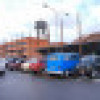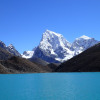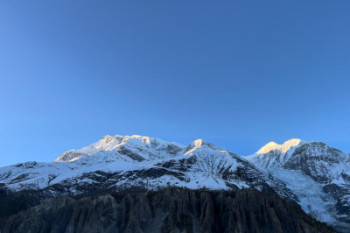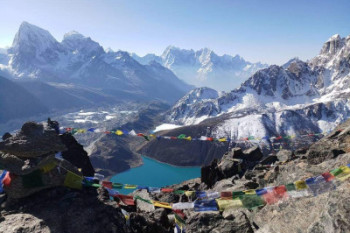
Embark on a luxurious Nepal tour with a private helicopter ride over Mount Everest, offering breathtaking views of the majestic Himalayan peaks. Experience the essence of Nepal's natural beauty and cultural heritage in just two days, exploring UNESCO sites and immersing in the local culture.
Trip Highlight
- Jaw dropping views of peaks and mountains including Mt. Everest, Cho-oyu, Nuptse, Ama-Dablam, Cholatse, Lobuche, Lhotse etc.
- Magnificent aerial views of rivers, lakes, glaciers, snow-capped mountains and icefalls.
- Flying over Sagarmatha national park, UNESCO World heritage site, world’s famous wildlife park.
- Helicopter landing on the highest point of planet, Kalapatthar.
This is a luxurious, short tour of Nepal that provides an extraordinary opportunity to experience the beauty and grandeur of the world's highest mountain, Mount Everest. Unlike most people who trek for days to get there, you will fly in a private helicopter over the stunning snow-capped mountains and surrounding peaks, allowing you to experience the serenity and freedom of the Himalayas. The Mahalangur Himalayan range and Mount Everest, soaring over the clouds, offer mesmerizing views that make this luxury trip special. You will land on Kalapaththar, the best viewpoint for Mount Everest, which will leave you amazed and inspired by the majestic views of the gigantic Himalayan ranges. This tour is perfect for those who do not have enough time for a long and difficult trek in the foothills of mountains. It is a dream come true for those who want to explore and encounter world-class views while enjoying a delicious breakfast in the world's highest altitude five-star hotel.
Before this thrilling experience, you will be taken on a guided city tour of Kathmandu valley where you will visit top UNESCO world heritage sites. This tour offers a real sense of Kathmandu's historical and cultural roots, showcasing the arts, architecture, palaces, temples, stupas, gombas, rituals, religions, and other elements that narrate the stories of centuries-old civilizations in Kathmandu valley and Nepal in general.
This two-day tour offers a complete and beautiful combination of Nepal's utmost adventurous natural heritage in the Himalayas and material/cultural heritage of Kathmandu valley. Despite visiting only two sites, you will be truly amazed by the glimpse of Nepal that you will get in just two days.
For more varieties of Heli Tour Packages, click here
Show more...Places Visited:
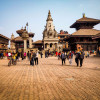
Kathmandu
kathmandu, Nepal
Activities:
Arriving in Kathmandu by flight is an unforgettable experience due to the stunning views of the Himalayan mountain range. Your flight will land at Tribhuwan International Airport (TIA), which is located at an altitude of 1350m. Upon arrival, you can obtain your Nepal entry visa either in advance or upon arrival at TIA, and it may take up to 45 minutes to process the visa depending on the queue. For more information about obtaining the Nepal entry visa, please refer to the official website of the Department of Immigration Nepal. Once you exit the airport gate, you will be greeted by a representative of our company who will be holding a placard with our company's name and logo. Our representative will offer you a holy Tibetan scarf as a welcoming gesture and take you to your hotel in a private vehicle. The journey from TIA to Thamel, where the hotel is located, takes approximately 30 minutes. Along the way, you will see the city's sights, such as the Pashupatinath Hindu temple, bustling with various vehicles and people, which will make your journey more enjoyable and fascinating. Upon reaching the hotel, you can rest and freshen up. Thamel is a lively area with plenty of restaurants, shopping centers, and good accommodations. Later on, we will provide a trip briefing and invite you to a welcome dinner. You will spend the night at the hotel.
Show more...Places Visited:
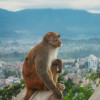
Swayambhunath
kathmandu, Nepal
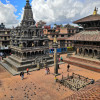
Patan Durbar Square
kathmandu
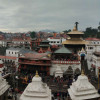
Pashupatinath
kathmandu
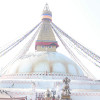
Bouddha Stupa
kathmandu
Activities:
Kathmandu guided city tour includes four major UNESCO world heritage sites in Kathmandu valley, major civilizational attractions. These four sites give you wonderful insights to various aspects of different religious/spiritual/historical segments of Nepalese society in both past and present. Swoyambhunath tells you the story of how present day Kathmandu valley, then Nag Daha (Snake Lake), was converted in to wonderful place of human settlement from Himalayan Buddhist’s perspective. Patan Durbar square is a reflection of magnificent arts and architecture that existed in and around the valley in the recent and distant past. Pashupatinath temple narrates you the tale of Sanatan dharma (understood as present day Hinduism) in Kathmandu valley as to how it originated and evolved throughout various time periods. It also illustrates how this site is profoundly linked to all Hindus worldwide. Bouddha Stupa represents another facet of Himalayan Buddhism and its evolution throughout the history and also gives you a clear picture of how Tibet and Nepal are deeply connected through this site.
Swayambhunath Stupa
- Swoyambhunath holiest Buddhist stupas in Nepal
- World Heritage Sites
- Literally meaning "self- created"
- Praised and meditated by many Buddhas: Shikhi, krakuchhand, kanakmuni, Shakyamuni, Manjushri
- Excellent view of the Kathmandu valley The distance is about 3.9km from Thamel takes around 15min in private vehicles.
Swayambhu has been listed in the World Heritage Sites. The entire valley was an enormous lake, nagdah, out of which grew a lotus with five colored flame (self-arisen). Lotus was transformed into a hill and the flower became the stupa. It is still believed that the self-arisen flame is covered with dome of Stupa. The place is known as Swayambhu, meaning "Self-Created" over which a stupa was later built. Swayambhu is among the oldest religious sites in Nepal known as 'monkey temple' because of the large tribe of roaming monkeys. Located at one of the highest elevations in Kathmandu Valley gives panoramic views of the city. The place is praised by Buddha and meditated by several Buddha's as a pure holy site. We'll see three enormous shining golden statues of Sakyamuni Buddha, a four-armed Chenresig and Guru Rinpoche, built-in 2003. The site has two access points: a long staircase contains 365 steps leading directly to the main platform of the temple and vehicle road around the hill from the south leading to the south-west entrance. The first sight on reaching the top of the stairway is the enormous Vajra. The first earthly element facing the stupa on left is a small building contains one of the five elements placed in cardinal points around Swayambhunath. There are many small shrines with statues of Tantric and shamanistic deities, prayer wheels for the Tibetan Buddhists. The stupa represents Buddha’s mind. It offers peace, freedom, and joy and ultimately helps to obtain perfect enlightenment. Huge prayer wheels and fine Buddhist paintings are displayed in the monasteries, as well as the largest Buddha statue in the country. The stupa consists of a dome at the base; above the dome, there is a cubic structure with the eyes of Buddha looking out over the valley. The stupa has stood as a hallmark of faith and harmony for centuries with Hindu temples and deities incorporated in this Buddhist site. Visitors walk around the stupa and recite mantras, make offerings, turn prayer-wheels and make wishes for the benefit of all beings. Near the stupa left at the corner is a small red brick building has Swayambhu Buddhist museum. There is a collection of Buddhist statues and items. Hariti Temple (Ajima Temple) is a two-tiered gilded Newari style temple. Harati is the Buddhist goddess for the protection of children against infectious diseases, protectress deity of Swayambhu, and the deity of wealth. Patan Durbar Square City of fine arts. Golden Temple, Mahabuddha It is one of the three medieval cities in Kathmandu and a destination of fine arts has hundreds of fascinating Hindu and Buddhist monuments scattered in and around.
Patan Durbar Square
Patan City is an enchanting mixture of palace buildings, artistic courtyards, and former palace complex. Most of the monuments are back to the medieval Malla period 15th to 17th century as the golden period of Nepalese art and architecture. Krishna Mandir- a stone temple of Lord Krishna with its 21 spires and bas-relief art depicting scenes from the Mahabharata and Ramayana epics. In addition to this, the main highlights are the Golden temple, Rudravarna Mahabihar and Patan mahabuddha, an exemplary Buddhist monumental sites in Patan. The background, story and history of these sites will amaze you while witnessing a living history. The stories behind the development of different segment in Buddhism, Bajrayan, which is a typical Newari Buddhist practice in Kathmandu valley. Patan is also the center of wooden and metal artifacts.
Pashupatinath Temple
- Most sacred Hindu temple
- Famous for the shrine of lord shiva
- Two-storied pagoda temple
Pashupatinath Temple is one of the most sacred Hindu temples of Nepal located at the banks of holy Bagmati River. Every year this temple attracts hundreds of elderly followers of Hinduism. The place for different festival like Maha Shivaratri and Teej where thousands of devotees celebrate. The temple is the ultimate pilgrimage for Hindus throughout the world. The area is swarmed in by the Hindus from different part of the country. The two-storied pagoda temple of Pashupathinath houses the five-faced statue of Lord Shiva. Apart from the main shrine, there are numerous temples dedicated to different god and goddess in and around the Pashupatinath temple area. This temple is an important destination for art historians. It displays a variety of temple design some of which are Dome style, Pagoda style, Shikhara style and so on. Additionally, there are varieties of statues and sculptures around the complex. There are statues made of stone, metal, and wood. The door and pillars around the temple area are carved in beautiful shapes of God and griffins. The temple is built in the pagoda style of architecture, with cubic constructions and carved wooden rafters on which they rest, and two-level roofs made of copper and gold. After we continue to Boudhanath Stupa which is 2.3km from here takes around 15min to reach.
Boudha Stupa
- The largest stupa in the world
- Most sacred Tibetan Buddhist site
- The ancient trade route from Tibet
- The woman built the stupa and was completed by her four sons
- Stupa contains a relic of Kashyap Buddha On the rooftop restaurant and enjoy the calm and peaceful ambience with a cup of coffee.
Boudha stupa is the largest and most sacred Tibetan Buddhist site outside of Tibet forming a religion and culture hub for the Tibetan and people from the Himalayas of Nepal. The Stupa was on the ancient trade route from Tibet. The Stupa is claimed to have the relic of Kasyapa Buddha, the third Buddha of the Bhadrakalpa. Boudha Stupa, a UNESCO World Heritage Site significant for its historic and architectural significance, with sprouting monasteries and craftsmanship. It is said that the stupa is built by the mother Jyajhima, a poultry woman. She was very poor despite her poverty she had an intense desire for building a stupa. The mother passed away after she completed up to the vase, the dome-like structure. She had four sons, and the construction of the rest of the Stupa was completed by four sons. After they finished it, they all stood up in front of it and made prayers. Everyone made their wishes. When they were praying, all the buddhas and bodhisattvas were absorbed into the stupa, which is why the name of the stupa is also “All-Encompassing.” The stupa is a semicircular white dome and the towering spire, with unblinking eyes painted on each side that stares into the four directions. The overall shape represents a Buddhist mandala (a cosmological map) and the path towards enlightenment, as well as the mythical center of the cosmos, Mount Meru. The four Dhyani Buddha signifies the crucial points, and the fifth, Vairocana is enshrined in the central white hemisphere of the stupa. The base of the stupa consists of three large platforms, decreasing in size. The square tower is topped by a pyramid with 13 steps, represents the stages that human beings must pass through to achieve nirvana. The triangular shape is the abstract for the elements of fire. Every portion has a symbolic significance: the base, dome, spire, and pinnacle represent the five elements. It is said that the stupa contains a piece of bone from the skeleton of Siddhartha Gautama, the historical Buddha. There are 108 images of Dhyani Buddha at the base of the stupa, accompanied by prayer wheels organized in a group of four or five in 147 different niches. The prayer flags tied on the stupa are believed to carry mantras and prayers towards heaven. The place is quiet and peaceful to find some spiritual connection with this place. Moreover, the sound of singing bowls and Buddhist chants, mixed with the smell of incense burning creates a kind of healing energy. The place allows visitors to delve into the lives of Buddhist monks and nuns who devote their lives to simplicity and non-violence. Boudhanath is the best place to learn about spirituality, meditation and the history of Buddhist philosophy, there is no other place like Boudhanath to visit. Early in the morning and evening time, Buddhist monks in maroon robes are seen circumambulating the stupa with prayer wheels on their hands. Small peripheral of the stupa is surrounded by the Thanka and rituals objects shop. The spot is favorable to explore both the culture and architectural sites. Numerous small stupas are located at the base.
Show more...Places Visited:
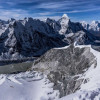
Kala Patthar (काला पत्थर)
Kalapatthar, Nepal
Activities:
After the completion of insightful as well as joyful tour of major sites in Kathmandu valley, today is the day for mountain adventure as you are going to experience the most thrilling and breathtaking flight over highest peaks in the world. The tour provides you with an opportunity to see highest peaks up close and be at the top of the world.
Below is a general itinerary for today’s trip to Mt. Everest:
5.00 am-5.30 am: you wake up, freshen up and you will be driven to domestic airport. You are advised to carry water bottles, passport, light snacks, dry foods and prescribed medicine if you have any in your handbag.
5.30 am – 6.30: Check in at the domestic airport Helipad (1340m). We can expect some queue at the counter, you will present a passport to an airline official as well as your body weight will be weighed which is most important for Everest Heli tour. Once the boarding and security checking process are over, you will wait for an announcement and proceed towards Helipad. Your captain will brief about safety and other details.
6.30 am -7.30 am: Fly from Kathmandu domestic airport to Lukla airport (2860m). Flight from Kathmandu to Lukla is quite thrilling. If the weather is clear, Mt.Manasalu, Mt.Ganesh Himal, Langtang will be clearly visible on far west. Dense forests on the high hills covered with rhododendron, pine forest and traditional village settlement will look fabulous. You will be busy capturing such lifetime experience in your camera. After like 15 minutes of your flight, grand views of Mt. Gaurishankar and Melung-Tse peak will be welcoming you. After a while you could catch a glimpse of Mt. Everest and Mt. Lhotse while heading slowly north to Lukla airport, a unique airstrip for landing and takeoff.
7.30 am- 8.00 am: Landing at Lukla airport and fueling up. Small break for 30 minutes.
8.00 am -8.35 am: Fly towards Everest Region. If your group has more than 3 people or weighs more than 250 kg, we will need to divide you and use a shuttle service with the same helicopter from Pheriche, which is at an altitude of 4,200 meters. Once the helicopter takes off, it will follow the Dudh-Kosi River that originates from the glaciers near the Everest base camp, known as the Khumbu glacier. The flight will provide views of villages with many lodges and tea houses, which trekkers and climbers use as they follow the trails through rhododendron and pine forests. After a while, you will see Namche Bazaar, Khumjung, and Phortse on the left side of the helicopter, and as you continue, you will get a front-facing view of Mt. Everest, Lhotse, and Ama Dablam. On the left side of the helicopter, you will also see Mt. Cho-Oyu, the sixth highest peak in the world, as you fly over the famous and largest Tengboche Monastery. The helicopter will pass over Pangboche to reach Pheriche, a moderate-sized settlement with many nice hotels and lodges situated at an altitude of 4,200 meters. The pilot may land the helicopter at Pheriche to split the group into two groups of 2 people and 3 people, dividing the weight of 250 kg or less. The first group will continue to the Everest base camp while the second group waits at Pheriche and enjoys taking photos and videos. The same helicopter will shuttle back and forth ferrying passengers.
Once you have completed your mesmerizing sky adventure in Everest region, the helicopter will fly back to Kathmandu domestic airport and our office representative will be waiting there to pick you up from airport and drop you to your hotel. You can chill and relax at your hotel recalling your best experience you just had. In the evening, we will organize a farewell dinner program for you.
Show more...Activities:
One of our office representative will see you off the airport. It’s time to bid farewell and we look forward to possibility of seeing you in the future.
Show more...Inclusions & Exclusions
Show more...- Airport pick up & drop off in private vehicle
- Three star category Hotel accommodation in Kathmandu with BB plan.
- All necessary paper works
- All local taxes.
- Domestic flights.
- All necessary ground transportation in a comfortable private vehicle
- Kathmandu valley sightseeing with professional English speaking Tour Guide
- First air kit box.
- Government registered Tour Guide throughout the trip
- Chartered Private Helicopter
- Nepal entry visa fee & international airfare.
- Lunch & dinner while you are in Kathmandu.
- Hotel upgrade & any other add on.
- Extra stay in Kathmandu.
- Personal travel insurance and insurance covering medical & high altitude rescue costs.
- Private & customized trip.
- Tip for guide & porter.
- Filming devices: camera, drone, permit fee.
- All those not included in the list of inclusions.
- Personal Travel Insurance
- Lunch & Dinner
No reviews yet
Similar Tours
Embrace Adventure: Elevate Your Travel Experience with Our Irresistible Tours!
Everest Base Camp through Gokyo Lake
Embark on the iconic Everest Basecamp trek, experiencing the must-do adventure that captivates thousands annually....
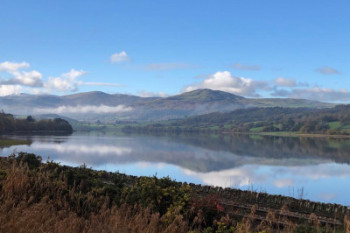
19 days | 18 nights
$ USD 1650
Annapurna Circuit Trek
Experience the allure of one of the world's iconic long-distance trekking trails, renowned for its breathtaking...
